Andorra - Expand or Die?
Situated high in the Pyrénées, close to the border with the principality of Andorra, is a large bowl. It is one of those secret spots. Ignored by the package tourists making their way to the slopes and tax free shops of Andorra. Novice ski tourers can train on the gentle 500 meter climb to the Pic de la Mina knowing that they are not far from civilization if things go pear shaped. Experts can explore the many couloirs that descend from the ridgelines. The whole area is reached after a short climb from the ski lifts of the French resort of Porté-Puymorens.

The slopes from the Pic de la Mina
All that is set to change following a recent decision by the French supreme court giving the green light to a new development. Porte des Neiges is a project to create a resort linking the Andorran ski domain of Gran Valira with the French resort of Porté Puymorens. Work is scheduled to start in the summer of 2005.
This article continues our series about France’s disappearing off-piste and the environmental impact that hyper-resorts are having on the mountain. Following our article on l’Alpe d’Huez in August some readers have commented that surely the extension of domains benefits off-piste enthusiasts by opening up new parts of the mountain? It could also be argued that what we are seeing now, in the Espace Diamant in the Haute Savoie, les Sybelles in the Maurienne and at Porté Puymorens is a significant infilling of the remaining wild areas between resorts and a reduction in the overall off-piste available. This does not even take into account ignores the often significant environmental impact that these continuous ski domains have on the flora and fauna of the mountains.
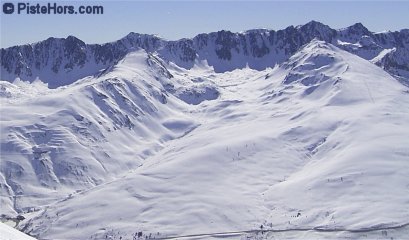
Porte Puymorens’ backcountry and the site of the new ski resort
Since their inception ski resorts have struggled with problems of profitability. The lessons from Courchevel, developed in the post war euphoria of thetrente glorieuse, were to let the state finance infrastructure and run costly lifts allowing developers to make tidy profits selling the maximum number of apartments in the shortest time possible, often before the first slab of concrete had even been poured. Promotional literature would include photos taken in other resorts, sometimes in other countries. Although the original architects at Courchevel had envisaged a resort of modern looking, single pitched roofed chalets constructed in harmony with the mountain, promoters realized that the real money was to be made throwing up vast blocks of miniscule studios crammed with beds.
The avalanches of 1970 put paid to this model. With the season concentrated on just a few short months a significant investment was standing idle for much of the year. Pierre Schnebelen thought he had the solution with year round glacier skiing. The Vanoise national park was amputated to accommodate his plans at Tignes and Val Thorens. An indication that where the ski business is concerned environmental issues would take second place in French government thinking.
Schnebelen didn’t factor a nascent green movement and climate change in his plans, by the early 1970s the glaciers were already in retreat. A solution had to be found to shift apartments. The 1970 avalanches had killed over a hundred people including 39 children in the UCPA chalet in Val d’Isère as they ate breakfast. Despite a cover up it was clear that much recent construction had been built directly in the path of potential avalanches. To relaunch the public’s appetite for investing in ski property the resort of Super Dévoluy came up with the idea of timeshare. This and many variants were widely adopted elsewhere.
All was back in order, for a while. However an aging infrastructure, increasingly erratic winters and a dated product that compared poorly with international competition would lead to repeated crisis in the industry.
By the late 1980s it was clear that the industry would have to rationalize and seek new investment to survive. In economically impoverished areas such as the Southern Alps the European Union would become an important source of funds for ski areas. In the richer Savoie departments the French State, in the form of the Caisse des Depots [CDD], sought to federate ski areas. As an aside, civil servants from the CDD were actively involved in siezing Jewish assets during the second world war. In 1994 the CDD listed the Compagnie des Alpes on the 2nd market of the French stock exchange. The strategy adopted by the CdA has come to dominate current French thinking:
• large ski domains for economies of scale
• high altitude for good snow cover
• an international reputation to ensure maximum occupancy outside the main French holiday period.
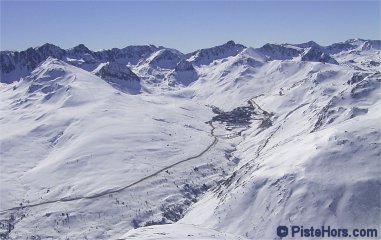
Pas de la Casa and the road from France
The development at Porte des Neiges will include 80,000 square meters of buildings housing some 4,500 beds. The resort will face Pas de la Casa. The slopes will be served by 3 high-speed 6 seater chairlifts. The lifts at Porté Puymorens will also need to be extended to facilitate the return journey. The resort will be one of the world’s great ski areas with slopes from 2,650 to 1,875 meters offering continuous skiing from Canillo in the heart of Andorra to Porte Puymorens in France.
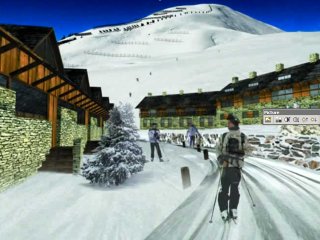
An artists impression of Porte des Neiges
Apart from the loss of off-piste the proposals have met with opposition from environmental groups such as the Andorra based Association for the Defense of Nature (ADN) who claim that the development threatens a zone of great ecological value.
ADN claim that the area affected is the habitat of several species of animals and more significantly very rare plants including some considered in danger of extinction. The project will create a continuous ski domain of several thousand hectares. ADN believe that these hyperdomains fragment the mountain ecology of the area. Our visit to the site suggests that considerable landscaping (think dynamite and bulldozers rather than Charlie Dimmock and decking) will be required, particularly to create pistes on the Porté Puymorens side.
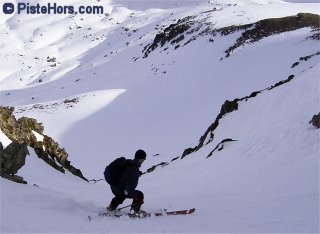
The slopes down to Andorra present some challenges
ADN accuse the developers (presumably including the Viladomat family who control Pas de la Casa and Grau Roig) of a lack of scruples and say they are only concerned with profit not with sustainable development that supports the local communities.
The website: [url=http://www.portedesneiges.com]http://www.portedesneiges.com[/url] states that the Viladomat family are associated with the French promoter SACRESA S.A. It gives an interesting perspective on the strategy behind the development of a ski resort in the 21st century with talk of Strategic Business Units (SBUs) etc. In a blast from the past the photographs in the brochure appear not to come from nearby Andorra but illogically from l’Espace Killy in the French Alps!
Notionally under the control of the French President and the Spanish Bishop of Urgel, Andorra – the land of princes, existed for over 700 years as a feudal state before transforming itself into a parliamentary democracy in 1993. The economy is largely based on tourism and the re-export of tax-free goods to neighbouring France and Spain. Andorra is also a tax haven that, at the time of writing, is top of the OECD’s target list of uncooperative states. Despite the 11 years of democracy Andorran affairs can still seem murky as we’ll discover.
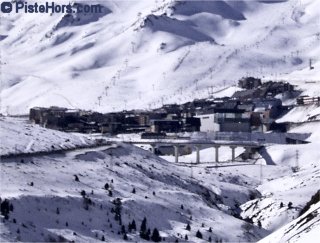
Pas de la Casa and the controversial viaduct
After years of chasing cheap and cheerful package tourists the project is all part of Andorra’s plan to turn Grand Valira into a high-class ski domain of international standing. Even if Pas still resembles the wild west, posh new hotels have been built at Grau Roig and Soldeu and the plans for Porte de Neiges are for accommodation of similar standing with the emphasis on ski-in ski-out. In order to realize this plan the principality, which possesses no airport, needed to improve connections with France and this entailed the construction of a tunnel and a viaduct just below Pas de la Casa inside French territory. The French government were understandably not keen to finance this project and instead agreed to exchange around 1.6 hectares of French territory if the Andorrans agreed to pay for the bridge. Pierre Moscovici, European Minister in the former Socialist government said the scheme would favour Franco-Andorran economic development. As the principal export of Andorra is tax-free fags and booze it is not initially clear how this will help French shop keepers in the border areas. Moscovici claims that the land exchange was necessary so that a bridge built by the Andorrans was not under French jurisdiction.
The French government has said that French landowners have been compensated with land offered by Andorra and as their land was currently zoned for agriculture there would be no loss. Except for the little fact that the Andorrans could do what they wished with the territory they had acquired and wanted it to extend their ski area. A point that was not lost on some locals in Porta on the French side of the border. They have accused the tiny tax haven of annexing their territory especially after an alleged further 35 hectares of French land was acquired by diverting the course of the river Ariège, the traditional border between the two states, by the construction of a series of dykes. They say this was done to permit Andorra to extend the domain of Grand Valira into French territory without asking for planning permission from the French authorities. Pierre Moscovici thinks that residents on the border region should see the bigger picuter. He believes that the development of Porte des Neiges will bring economic development to a poor area. Maybe but perhaps the locals may be right to be concerned. Development in the Alps has often benefitted outsiders with the locals, more used to eeking a living from mountain agriculture, poorly placed to take advantage of the changes.
Posted by
davidof on Tuesday, 12 October, 2004 at 12:55 PM
Work on the high speed six seater chair that will form a key link in the Porte des Neiges extension of the Grand Valira domain has begun. The chair is being built by Pomagalski and will transport 3,000 skiers per hour over a length of 1.3km. The area will eventually add 50km of ski runs.
Posted by
davidof on Thursday, 23 June, 2005 at 05:19 PM
A quick update on the Porte des Neiges project. On the 3rd of February, 2006 the six seater l’Estany chair opened serving two blue runs on the French side of the border: Les Amateurs and l’Union.
The rest of the project is waiting for planning permisison for 4,000 beds.
Posted by
davidof on Monday, 23 October, 2006 at 08:34 AM
Page 1 of 1 pages
Comments are now closed






